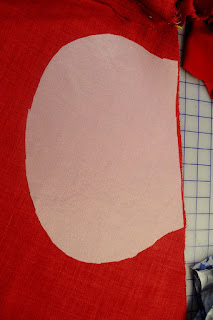I'm posting this as a back up for my Sewing Group to refer to if they want to make one of theses tops out of class.
Directions For Diana's Top
About cutting out your top
*** Lay your fabric on cutting surface by folding it right sides together with selvedge of each side together as well. It's very important that the folded edge be smooth. You'll have to work and refold the fabric until you get a smooth fold. You may have to cut off your selvedges to make this happen.Don't worry if the selvedge end is not exactly together.
*** Lay your pattern on the fabric. Don't forget to measure the distance between the STRAIGHT OF GRAIN AND THE FOLDED EDGE AT SEVERAL SPOTS TO MAKE SURE YOUR PATTERN IS LAYING STRAIGHT.
***Use weights rather than pins to make your job much easier.
*** Check your stitch length. It should be at least 2.5 or 3 because you are sewing on knit fabric.DIRECTIONS:
Step 1... Cut out the top being careful not to let the fabric move out of place. Cut little snips at the dots along the pleat area. mark where the fold for the pleat is.
Take away the pattern but don't move the top.
Step 2... Pin the lower half of the two layers together from just below the armhole to the hem.
Step 3... Fold back the top layer of the upper half. Lay the FRONT NECKLINE TEMPLATE on the neckline of the bottom layer matching the notches at center neckline.. Cut out front neckline.
Step 4... Pin front and back shoulder seams together .
Step 5... Sew shoulder seams using a 1/2" seam allowance. ( DO NOT SEW THE SLEEVE OPENINGS TOGETHER ! ASK RUTH AND ALEXA WHY !?!? )
Serge finish the shoulder seam and neckline.
.
Step 6... On both sides,Sew side seams as far as point A . Don't forget to back stitch for this and the next two seams.
Sew from A to B
Sew from B to C.
Serge side seams but only to point A.
THE HARD PART IS DONE. TAKE A BREAK!
Step 9... Finish neckline by either folding neck edge 1/4 " and top stitching or you can use Steam-a Seam.
To hem sleeves and bottom of top, first apply Steam-a-Seam to stabilize the hem area.
Sew hems using either a twin needle or a straight stitch.
That's it. You're finished. I hope you like what you made and that you had fun making it !!

















































